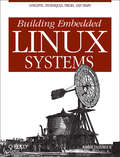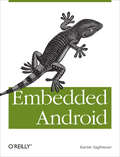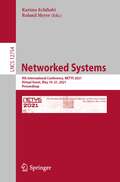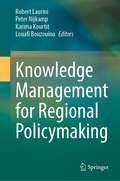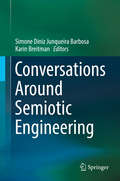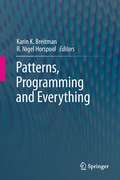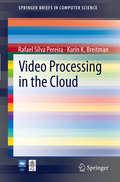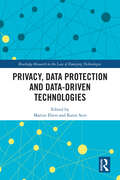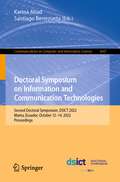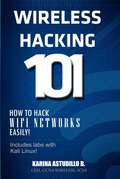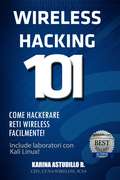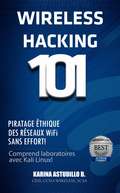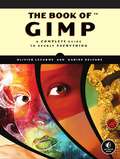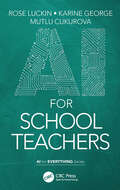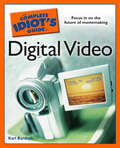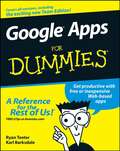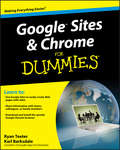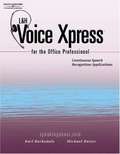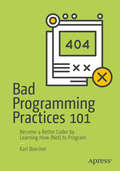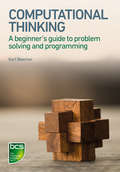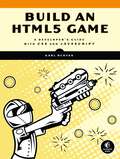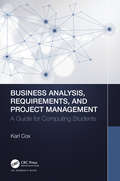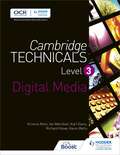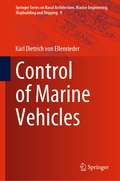- Table View
- List View
Building Embedded Linux Systems
by Karim YaghmourLinux® is being adopted by an increasing number of embedded systems developers, who have been won over by its sophisticated scheduling and networking, its cost-free license, its open development model, and the support offered by rich and powerful programming tools. While there is a great deal of hype surrounding the use of Linux in embedded systems, there is not a lot of practical information. Building Embedded Linux Systems is the first in-depth, hard-core guide to putting together an embedded system based on the Linux kernel. This indispensable book features arcane and previously undocumented procedures for:Building your own GNU development toolchain Using an efficient embedded development framework Selecting, configuring, building, and installing a target-specific kernel Creating a complete target root filesystem Setting up, manipulating, and using solid-state storage devices Installing and configuring a bootloader for the target Cross-compiling a slew of utilities and packages Debugging your embedded system using a plethora of tools and techniquesDetails are provided for various target architectures and hardware configurations, including a thorough review of Linux's support for embedded hardware. All explanations rely on the use of open source and free software packages. By presenting how to build the operating system components from pristine sources and how to find more documentation or help, this book greatly simplifies the task of keeping complete control over one's embedded operating system, whether it be for technical or sound financial reasons. Author Karim Yaghmour, a well-known designer and speaker who is responsible for the Linux Trace Toolkit, starts by discussing the strengths and weaknesses of Linux as an embedded operating system. Licensing issues are included, followed by a discussion of the basics of building embedded Linux systems. The configuration, setup, and use of over forty different open source and free software packages commonly used in embedded Linux systems are also covered. uClibc, BusyBox, U-Boot, OpenSSH, thttpd, tftp, strace, and gdb are among the packages discussed.
Embedded Android
by Karim Yaghmour<p>Embedded Android is for Developers wanting to create embedded systems based on Android and for those wanting to port Android to new hardware, or creating a custom development environment. Hackers and moders will also find this an indispensible guide to how Android works.</p>
Networked Systems: 9th International Conference, NETYS 2021, Virtual Event, May 19–21, 2021, Proceedings (Lecture Notes in Computer Science #12754)
by Roland Meyer Karima EchihabiThis book constitutes the revised selected papers of the 9th International Conference on Networked Systems, NETYS 2021, held virtually in May 2021.The 15 revised full papers and 2 short papers presented were carefully reviewed and selected from 32 submissions. The papers are organized in the following thematic blocks: distributed systems, blockchain, and verification.
Knowledge Management for Regional Policymaking
by Peter Nijkamp Karima Kourtit Robert Laurini Louafi BouzouinaThe present publication focusses the attention on new avenues in regional information and knowledge management, while we will zoom in particularly on the potential promises and hurdles of digital technology. This digital challenge has already generated a wealth of implications in the area of smart or intelligent cities, but as yet far less has been achieved in the field of regional planning and regional science. There is clearly a need for a more systematic and wide-ranging assessment and presentation of emerging approaches and concepts in this field, for instance, in regard to principles (e.g. geographic rule modeling), methodologies (e.g. blockchain systems), data analytics (e.g. machine learning) and data governance (e.g. data sovereignty) of regional information and knowledge. Especially in our ‘big data’ era, a systematic, comprehensible and reliable acquisition, storage, sharing and handling of data (e.g. on the basis of systematic decomposition and filtering principles) is more needed than ever before. The present study seeks to present a selection of state-of-the-art contributions on advanced – often digitally-oriented – regional information and knowledge management foundations, principles and practices written by several experts in the field of spatial informatics. These contributions were collected with a view to the design of a comprehensive knowledge and research agenda, which was discussed during a brainstorm workshop in Lyon, France (October 2021). This book covers various fields of interest, such as GeoAI, knowledge modelling, IoT and scalability, space syntax, rule extraction, data governance and data self-sovereignty. It is concluded with a knowledge and research agenda outlining future endeavors in the field of the spatial information sciences (or spatial informatics).
Conversations Around Semiotic Engineering
by Simone Diniz Junqueira Barbosa Karin BreitmanDemonstrating the influence of Semiotic Engineering in Human-Computer Interaction, this book focuses on the work of one of the pioneers of the field - Clarisse de Souza - and her influence on this broad and wide-ranging area of research. It contains a selection of essays written by those that have worked with her over the years and will encourage readers to extend their reading and research in this area. Clarisse de Souza, widely known as the founder of Semiotic Engineering, will reach her 60th birthday in 2017, and the Semiotic Engineering Research Group that she founded will also celebrate its 20th anniversary. A key figure in HCI, Clarisse argued that human-computer interaction enables computer-mediated communication between the designer and the user at the point of interaction thus enabling and facilitating designers in understanding who their users are, and what their requirements may be. This book brings together prominent researchers who have helped to shape semiotic engineering by their insightful discussions on the theory.
Microsoft in the Mirror: Nineteen Insiders Reflect on the Experience
by Karin CarterFormer and current employees of Microsoft share their experience.
Patterns, Programming and Everything
by Karin K. Breitman R. Nigel HorspoolWith 11 invited submissions from leading researchers and teams of researchers sharing one common characteristic ? all have worked with Dr. Judith Bishop during her long and continuing career as a leader in computer science education and research ? this book reflects on Dr Bishop?s outstanding contribution to computer science. Having worked at three different universities she now holds a leadership position in the research division of a major software company. The topics covered reflect some of the transitions in her career. The dominant theme is programming languages, with chapters on object oriented programming, real-time programming, component programming and design patterns. Another major and related topic is compilers, with contributions on dataflow analysis, tree rewriting and keyword recognition. Finally, there are some additional chapters on other varied but highly interesting topics including smart homes, mobile systems and teaching computer science.
Video Processing in the Cloud
by Rafael Silva Pereira Karin K. BreitmanAs computer systems evolve, the volume of data to be processed increases significantly, either as a consequence of the expanding amount of available information, or due to the possibility of performing highly complex operations that were not feasible in the past. Nevertheless, tasks that depend on the manipulation of large amounts of information are still performed at large computational cost, i.e., either the processing time will be large, or they will require intensive use of computer resources. In this scenario, the efficient use of available computational resources is paramount, and creates a demand for systems that can optimize the use of resources in relation to the amount of data to be processed. This problem becomes increasingly critical when the volume of information to be processed is variable, i.e., there is a seasonal variation of demand. Such demand variations are caused by a variety of factors, such as an unanticipated burst of client requests, a time-critical simulation, or high volumes of simultaneous video uploads, e.g. as a consequence of a public contest. In these cases, there are moments when the demand is very low (resources are almost idle) while, conversely, at other moments, the processing demand exceeds the resources capacity. Moreover, from an economical perspective, seasonal demands do not justify a massive investment in infrastructure, just to provide enough computing power for peak situations. In this light, the ability to build adaptive systems, capable of using on demand resources provided by Cloud Computing infrastructures is very attractive.
Privacy, Data Protection and Data-driven Technologies (Routledge Research in the Law of Emerging Technologies)
by Martin Ebers Karin SeinThis book brings together contributions from leading scholars in law and technology, analysing the privacy issues raised by new data-driven technologies.Highlighting the challenges that technology poses to existing European Union (EU) data protection laws, the book assesses whether current legal frameworks are fit for purpose, while maintaining a balance between supporting innovation and the protection of individual’s privacy. Data privacy issues range from targeted advertising and facial recognition, systems based on artificial intelligence (AI) and blockchain, and machine-to-machine (M2M) communication, to technologies that enable the detection of emotions and personal care robots.The book will be of interest to scholars, policymakers and practitioners working in the fields of law and technology, EU law and data protection.
Doctoral Symposium on Information and Communication Technologies: Second Doctoral Symposium, DSICT 2022, Manta, Ecuador, October 12–14, 2022, Proceedings (Communications in Computer and Information Science #1647)
by Santiago Berrezueta Karina AbadThis book constitutes the refereed proceedings of the Second Doctoral Symposium on Information and Communication Technologies, DSICT 2022, held in Manta, Ecuador, in October 2022. The 15 full papers were thoroughly reviewed and selected from the 72 submissions. The papers present research in areas of intelligent systems, artificial intelligence, ICTs and their applications to the real world.
Wireless Hacking 101
by Karina Astudillo Roger WillisWireless Hacking 101 - How to hack wireless networks easily! This book is perfect for computer enthusiasts that want to gain expertise in the interesting world of ethical hacking and that wish to start conducting wireless pentesting. Inside you will find step-by-step instructions about how to exploit WiFi networks using the tools within the known Kali Linux distro as the famous aircrack-ng suite. Topics covered: •Introduction to WiFi Hacking •What is Wardriving •WiFi Hacking Methodology •WiFi Mapping •Attacks to WiFi clients and networks •Defeating MAC control •Attacks to WEP, WPA, and WPA2 •Attacks to WPS •Creating Rogue AP's •MITM attacks to WiFi clients and data capture •Defeating WiFi clients and evading SSL encryption •Kidnapping sessions from WiFi clients •Defensive mechanisms
Wireless Hacking 101: Come hackerare reti wireless facilmente!
by Karina AstudilloImparate come effettuare test di intrusione wireless facilmente con la suite Kali Linux! WIRELESS HACKING 101 – Come hackerare reti wireless facilmente! Questo libro è diretto agli entusiasti dell'informatica che vogliono specializzarsi nell'interessante settore dell'hacking etico e che vogliono sperimentare con i test di intrusione su reti wireless. Incontrerete informazioni passo a passo su come sfruttare reti Wi-Fi usando alcuni strumenti compresi nella famosa distribuzione Kali Linux, come la suite aircrack-ng. Argomenti trattati: Introduzione al Wi-Fi Hacking In cosa consiste il Wardriving Come procedere ad un Wi-Fi Hacking Monitoraggio di rete Attacchi a reti ed utenti Wi-Fi Come eludere i filtri MAC Attacchi ai protocolli WEP, WPA, WPA2 Attacchi al WPS Creazione di rogue AP Attacchi MITM ad utenti wireless e raccolta dati Come ingannare utenti wireless per eludere la cifratura SSL Dirottare le sessioni di utenti wireless Sistemi difensivi
Wireless Hacking 101: Piratage éthique des réseaux WiFi sans effort!
by Karina AstudilloWIRELESS HACKING 101 – Piratage éthique des réseaux WiFi sans effort! Ce livre est dédié aux passionnés d'informatique qui cherchent à explorer le monde du piratage éthique et qui veulent se lancer dans les tests d'intrusion sur les réseaux WiFi. Vous y trouverez des informations étape par étape sur la manière d'exploiter les réseaux WiFi à l'aide d'outils inclus dans la populaire distribution Kali Linux, comme la suite aircrack-ng. Sujets traités: Introduction au piratage WiFi En quoi consiste le Wardriving Méthodologie pour un piratage WiFi Analyser les réseaux sans fil Attaquer les réseaux WiFi et ses utilisateurs Contournement du filtrage par MAC Attaques pour les protocoles WEP, WPA, WPA2 Attaques par WPS Création d'un Rogue AP Attaques MITM aux clients WiFi et capture de données Tromper les clients WiFi pour contourner le cryptage SSL Détournement de session des clients WiFi Systèmes de défense
The Book of GIMP: A Complete Guide to Nearly Everything
by Karine Delvare Olivier LecarmeGIMP is a free alternative to Adobe Photoshop with tons of professional-grade features. But with so many powerful tools and menu options, GIMP can be difficult to master. Whether you're struggling to get started or trying to master some of GIMP's more complex features, you'll find the answers you're looking for in The Book of GIMP.The tutorials in the first half of the book walk you through essential GIMP skills, like resizing and cropping images, touching up spots and scratches, and customizing your work area. Illustrated, step-by-step instructions show you how to:–Improve the lighting and composition of images–Remove distortions and noise to make old and damaged photos look like new–Create stunning panoramas and digital collages using a series of photos–Make, edit, and export custom textures, logos, and animated GIFs–Work with selections, channels, and masks to edit images like a pro–Create colorful digital art, layer by layerThe book's second half offers a comprehensive reference to GIMP's many features, including color balancing, masks, filters, and plug-ins. You'll find tools described in unparalleled detail, with coverage of nearly every option and parameter.With illustrated tutorials and detailed references, The Book of GIMP is sure to become your one-stop guide to just about everything GIMP.
AI for School Teachers (AI for Everything)
by Rose Luckin Mutlu Cukurova Karine GeorgeWhat is artificial intelligence? Can I realistically use it in my school? What’s best done by human intelligence vs. artificial intelligence, and how do I bring these strengths together? What would it look like for me, and my school, to be AI Ready? AI for School Teachers will help teachers and headteachers understand enough about AI to build a strategy for how it can be used in their school. Examining the needs of schools to ensure they are ready to leverage the power of AI and drawing examples from early years to high school students, this book outlines the educational implications and benefits that AI brings to school education in practical ways. It develops an understanding of what AI is and isn't and how we define and measure what we value and provides a framework which supports a step-by-step approach to developing an AI mindset, focusing on ways to improve educational opportunities for students with evidence-informed interventions.
The Complete Idiot's Guide to Digital Video
by Karl BardoshJoin the digital revolutionWith the availability and affordability of digital movie-making equipment, it&’s now easier than ever for aspiring filmmakers to create the great movie they&’ve always wanted to make. From information on creating mini-films on a PDA to making low-budget, full-length digital movies, The Complete Idiot&’s Guide® to Digital Video provides all the information you need to turn your idea into reality.• A must-read for every film student or novice• Covers all aspects of production, from casting and directing to light and sound to digital editing• Includes 8–page, 4–color insert• Up–to–date recommendations on equipment and software• Clear, easy-to-follow instructions and guidance, as well as all the practical, artistic, and technical &“step–by–step&” advice that only an experienced writer/director can offer
Google Apps For Dummies
by Karl Barksdale Ryan TeeterGoogle Apps are Web-based, low-cost (or free!) office productivity tools that do everything those expensive applications do - and you can access them from any computer with an Internet connection. Google Apps For Dummies boosts your "app-titude" by giving you the low-down on choosing, setting up, and using these nifty and powerful gadgets for work or play. Whether you're an individual who wants to take advantage of iGoogle or an organization looking for an enterprise-wide training solution for users at all levels, this comprehensive, practical guide brings you up to speed with all of the basic information and advanced tips and tricks you need to make good use of every Google Apps's tool and capability. Discover how to: Get productive fast with free or inexpensive Web-based apps Design your perfect Start Page layout Choose among the different editions Use Gmail and Google Talk Work with Google Docs and spreadsheet documents Create and collaborate on documents Import events into your calendar Build dazzling presentations Use Dashboard to create and manage user accounts Create a Web page with a unique domain setting Google Apps are poised to shatter the primacy of the current way of working with PCs, saving businesses, schools, government agencies, and individuals big bucks on software, network infrastructure, and administration. Google Apps For Dummies is your key to making this revolutionary new approach work for you and your organization.
Google Sites & Chrome For Dummies
by Karl Barksdale Ryan TeeterCurious about Google Sites and how team collaboration Web sites can help you share documents online from various locations? Curious about Google's new Chrome browser? Google Sites & Chrome For Dummies has what you want to know! Today, Google is so much more than another word for "search. " Google Sites & Chrome For Dummies shows you how to create great collaborative Web sites with Google Sites and surf the Web with the super-fast Google Chrome browser. Find out how they work with other Google Apps, too. You'll learn to: Take advantage of free hosting, free tools, and a simple, straightforward interface with Google Sites Set up a Google account or Google Apps account Create wiki sites that let coworkers collaborate on projects or keep family members up to date Use Google gadgets to keep track of projects, manage calendars and documents, or display photos Integrate documents, spreadsheets, presentations, and other Google Apps into your site Work with Contact List, Google Talk, and Google Chat, and handle e-mail with Gmail Download and install the speedy Google Chrome browser Install browser plug-ins, enable offline access to Google Docs, and manage misbehaving tabs You'll even find instructions and examples to help you plan sites for personal and business use, plus a sample college course site. With advice from Google Sites & Chrome For Dummies, you can make collaboration easy and have the high-speed Web at your fingertips.
South Western L and H VoiceXpress for the Office Professional
by Karl Barksdale Michael RutterVoice typing is transforming the way people work, write, and enter data. With Voice X Press for the Office Professional, your students can learn the most effective way to use this new software and be able to apply it to the various office applications. This book takes students step-by-step through the speech learning process, providing tips and advice along the way.
Bad Programming Practices 101: Become a Better Coder by Learning How (Not) to Program
by Karl BeecherThis book takes a humorous slant on the programming practice manual by reversing the usual approach: under the pretence of teaching you how to become the world’s worst programmer who generally causes chaos, the book teaches you how to avoid the kind of bad habits that introduce bugs or cause code contributions to be rejected.Why be a code monkey when you can be a chaos monkey? OK, so you want to become a terrible programmer. You want to write code that gets vigorously rejected in review. You look forward to reading feedback plastered in comments like "WTF???". Even better, you fantasize about your bug-ridden changes sneaking through and causing untold chaos in the codebase. You want to build a reputation as someone who writes creaky, messy, error-prone garbage that frustrates your colleagues. Bad Programming Practices 101 will help you achieve that goal a whole lot quicker by teaching you an array of bad habits that will allow you to cause maximum chaos.Alternatively, you could use this book to identify those bad habits and learn to avoid them. The bad practices are organized into topics that form the basis of programming (layout, variables, loops, modules, and so on). It's been remarked that to become a good programmer, you must first write 10,000 lines of bad code to get it all out of your system. This book is aimed at programmers who have so far written only a small portion of that. By learning about poor programming habits, you will learn good practices. In addition, you will find out the motivation behind each practice, so you can learn why it is considered good and not simply get a list of rules.What You'll LearnBecome a better coder by learning how (not) to programChoose your tools wiselyThink of programming as problem solvingDiscover the consequences of a program’s appearance and overall structureExplain poor use of variables in programsAvoid bad habits and common mistakes when using conditionals and loopsSee how poor error-handling makes for unstable programsSidestep bad practices related specifically to object-oriented programmingMitigate the effects of ineffectual and inadequate bug location and testingWho This Book Is ForThose who have some practical programming knowledge (can program in at least one programming language), but little or no professional experience, which they would like to quickly build up. They are either still undergoing training in software development, or are at the beginning of their programming career. They have at most 1-2 years of professional experience.
Computational Thinking: A Beginner's Guide to Problem-Solving and Programming
by Karl BeecherComputational thinking is a timeless, transferable skill that enables you to think more clearly and logically, as well as a way to solve specific problems. <p><p> Beginning with the core ideas of computational thinking, with this book you'll build up an understanding of the practical problem-solving approach and explore how computational thinking aids good practice in programming, complete with a full guided example.
Build an HTML5 Game: A Developer's Guide with CSS and JavaScript
by Karl BunyanIf you already have even basic familiarity with HTML, CSS, and JavaScript, you’re ready to learn how to build a browser-based game. In Build an HTML5 Game, you’ll use your skills to create a truly cross-platform bubble-shooter game—playable in both desktop and mobile browsers.As you follow along with this in-depth, hands-on tutorial, you’ll learn how to:–Send sprites zooming around the screen with JavaScript animations–Make things explode with a jQuery plug-in–Use hitboxes and geometry to detect collisions–Implement game logic to display levels and respond to player input–Convey changes in game state with animation and sound–Add flair to a game interface with CSS transitions and transformations–Gain pixel-level control over your game display with the HTML canvasThe programming starts right away in Chapter 1—no hemming and hawing, history, or throat clearing. Exercises at the end of each chapter challenge you to dig in to the bubble shooter’s code and modify the game.Go ahead. Take the plunge. Learn to create a complete HTML5 game right now and then use your newfound skills to build your own mega-popular, addictive game.
Business Analysis, Requirements, and Project Management: A Guide for Computing Students
by Karl CoxIT projects emerge from a business need. In practice, software developers must accomplish two big things before an IT project can begin: find out what you need to do (i.e., analyse business requirements) and plan out how to do it (i.e., project management). The biggest problem in IT projects is delivering the wrong product because IT people do not understand what business people require. This practical textbook teaches computer science students how to manage and deliver IT projects by linking business and IT requirements with project management in an incremental and straightforward approach. Business Analysis, Requirements, and Project Management: A Guide for Computing Students presents an approach to analysis management that scales the business perspective. It takes a business process view of a business proposal as a model and explains how to structure a technical problem into a recognisable pattern with problem frames. It shows how to identify core transactions and model them as use cases to create a requirements table useful to designers and coders. Linked to the analysis are three management tools: the product breakdown structure (PBS), the Gantt chart, and the Kanban board. The PBS is derived in part from the problem frame. The Gantt chart emerges from the PBS and ensures the key requirements are addressed by reference to use cases. The Kanban board is especially useful in Task Driven Development, which the text covers. This textbook consists of two interleaving parts and features a single case study. Part one addresses the business and requirements perspective. The second integrates core project management approaches and explains how both requirements and management are connected. The remainder of the book is appendices, the first of which provides solutions to the exercises presented in each chapter. The second appendix puts together much of the documentation for the case study into one place. The case study presents a real-word business scenario to expose students to professional practice.
Cambridge Technicals Level 3 Digital Media
by Karl Davis Richard Howe Victoria AllenSupport your teaching of the new Cambridge Technicals 2016 suite with Cambridge Technical Level 3 Digital Media, developed in partnership between OCR and Hodder Education; this textbook covers each specialist pathway and ensures your ability to deliver a flexible course that is both vocationally focused and academically thorough.Cambridge Technical Level 3 Digital Media is matched exactly to the new specification and follows specialist pathways in digital content for interactive media, and moving image and audio production.- Ensures effective teaching of each specialist pathway offered within the qualification.- Focuses learning on the skills, knowledge and understanding demanded from employers and universities.- Provides ideas and exercises for the application of practical skills and knowledge.- Developed in partnership between Hodder Education and OCR, guaranteeing quality resources which match the specification perfectly
Control of Marine Vehicles (Springer Series on Naval Architecture, Marine Engineering, Shipbuilding and Shipping #9)
by Karl Dietrich von EllenriederThis textbook offers a comprehensive introduction to the control of marine vehicles, from fundamental to advanced concepts, including robust control techniques for handling model uncertainty, environmental disturbances, and actuator limitations. Starting with an introductory chapter that extensively reviews automatic control and dynamic modeling techniques for ocean vehicles, the first part of the book presents in-depth information on the analysis and control of linear time invariant systems. The concepts discussed are developed progressively, providing a basis for understanding more complex techniques and stimulating readers’ intuition. In addition, selected examples illustrating the main concepts, the corresponding MATLAB® code, and problems are included in each chapter. In turn, the second part of the book offers comprehensive coverage on the stability and control of nonlinear systems. Following the same intuitive approach, it guides readers from the fundamentals to more advanced techniques, which culminate in integrator backstepping, adaptive and sliding mode control. Leveraging the author’s considerable teaching and research experience, the book offers a good balance of theory and stimulating questions. Not only does it provide a valuable resource for undergraduate and graduate students; it will also benefit practitioners who want to review the foundational concepts underpinning some of the latest advanced marine vehicle control techniques, for use in their own applications.
